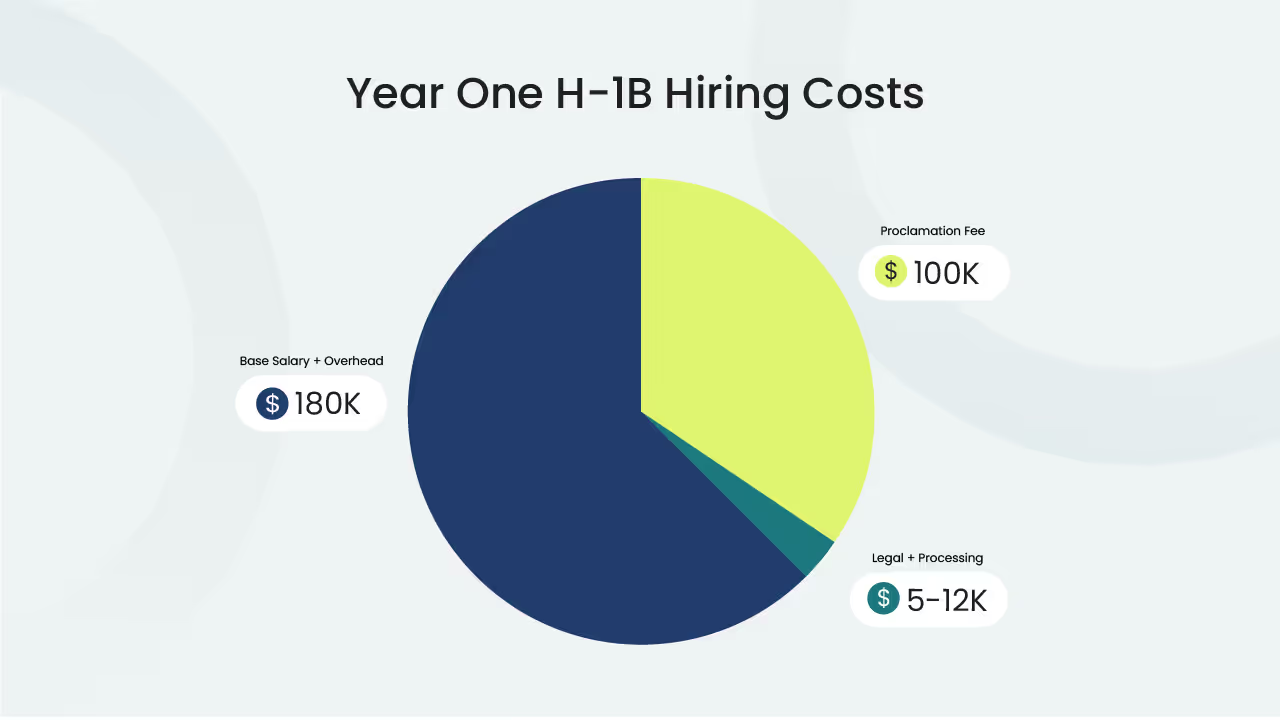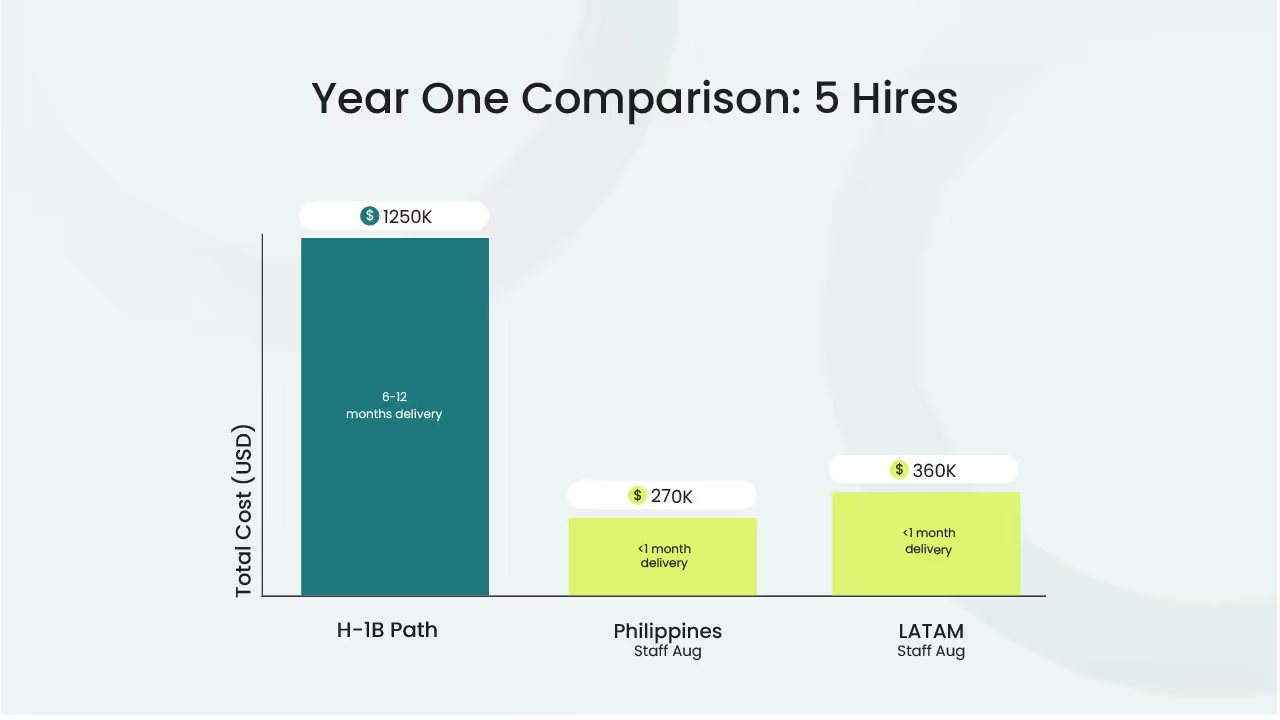H-1B vs Staff Augmentation: The True Cost of Hiring in 2025 and Why Costs Are Rising

📌 TL;DR
In September 2025, the US introduced a $100,000 fee on new H-1B visa petitions, sending hiring costs for non-US engineers soaring to $250K+ in year one once legal and benefits are included. While existing visas remain unaffected, uncertainty surrounds job changes and compliance. By contrast, staff augmentation is a flexible workforce model that allows companies to extend capacity internationally and deliver fully embedded engineers in 2–3 weeks at 50–75% lower cost. For CTOs and COOs, the choice is a matter of economics and risk.
Why Hiring Costs Are in Focus in 2025
Rising Salaries and Inflation
US software engineers are commanding record salaries. According to CompTIA’s 2024 IT Workforce Report, average tech wages grew 7% year-over-year, with senior developers in Silicon Valley averaging over $170,000 in base pay. Layer in healthcare, retirement contributions, payroll taxes, and overhead, and total annual employment costs for an in-house hire often surpass $220,000.
Visa-Driven Volatility
The September 2025 proclamation heightened uncertainty. As Fragomen explains, “The proclamation bans an H-1B specialty occupation employee from entering the United States unless their employer has paid a $100,000 fee… effective at 12:01 am EDT on September 21.” (fragomen.com). While this measure is limited to new petitions, open questions remain regarding changes of employer, amendments, and the impact of foreign travel.
Investor and Market Pressures
Venture capital and public markets are applying unprecedented scrutiny to workforce costs. Growth is no longer being rewarded at any price. Instead, investors are pressing leadership teams to demonstrate capital efficiency, not just topline expansion.
In PwC’s 2023 Pulse Survey, 87% of CHROs reported evaluating new ways to deliver HR value at a lower cost, with a growing emphasis on productivity gains through employee experience and generative AI adoption (PwC). This mindset has carried into 2025, where boards are holding technology executives accountable for cost per hire, time-to-productivity, and retention outcomes.
For startups, this means fundraising conversations now include pointed questions on burn multiples tied to engineering headcount. For listed enterprises, analysts are quick to penalize missed delivery tied to talent shortages or bloated hiring costs. Deloitte notes that financial markets increasingly reward companies that can demonstrate predictable workforce planning, treating it as a proxy for operational resilience (PwC).
The takeaway for CTOs and COOs is clear:
- Unpredictable hiring costs are no longer acceptable, they directly erode enterprise value.
- Extended hiring cycles risk missed revenue opportunities, a red flag for investors.
- Models like staff augmentation, which offer predictable costs and short hiring cycles, provide a strategic hedge against both operational and financial risk.
In short, investor pressure has transformed hiring from an HR issue into a board-level financial concern.
The Updated Cost of H-1B Hiring
Direct Costs for New Applicants (Post-Sept 21, 2025)
- $100,000 presidential proclamation fee (new petitions only).
- H-1B registration: $215 (effective FY2026).
- Legal fees: $3,000–$10,000 per petition.
- Optional premium processing: $2,500.
Indirect Costs
- Payroll taxes, health insurance, and benefits typically add 25–30% to base salaries.
- Compliance and legal monitoring costs rise with every policy change.
- Lottery failures create sunk costs with no return.
Time-to-Productivity
Even when petitions are approved, companies wait 6-12 months before an H-1B employee is productive. Delays are compounded by administrative backlogs and potential litigation over the proclamation.
First-Year Cost Impact
Consider a mid-level engineer with a $140,000 base salary:
- Base salary + benefits/overhead (~$40,000): $180,000.
- Legal + processing: $5,000–$12,000.
- Proclamation fee (new hire only): $100,000.
Total: $250,000–$290,000 in year one.

The Staff Augmentation Cost Breakdown
What is Staff Augmentation?
Staff augmentation is a flexible workforce model that allows companies to quickly extend their capacity with top-class professionals, without the delays, costs, and risks of traditional hiring. Unlike outsourcing, where a third party owns the project, staff augmentation keeps you in control: engineers work as embedded members of your team, following your workflows and tools. Learn more in our full guide: What is Staff Augmentation? And What Are the Benefits?.
Transparent Pricing
Cloud Employee’s staff augmentation model eliminates upfront risk. Companies pay a flat monthly fee:
- Philippines: $4,500/month (~$54,000/year).
- LATAM: $6,000/month (~$72,000/year).
This all-inclusive rate covers salary, benefits, HR, compliance, office infrastructure, and retention. There are no placement fees or $100k surcharges. See how much you could save with our cost comparison calculator.
Speed and Flexibility
- Hiring cycle: 1–3 weeks vs. 6–12 months for H-1B.
- Cancel anytime with rolling contracts.
- Scale teams up or down quickly to match project demand.
Culture and Retention
Cloud Employee engineers are fully embedded in your workflows and culture, collaborating daily with your in-house team. With a 97%+ retention rate beyond two years, our model ensures stability and avoids the churn of traditional outsourcing or contract hiring.
Explore our client case studies to see how Cloud Employee has helped businesses across industries scale effectively using staff augmentation.
Why Hiring Costs Are Rising Overall
Global Talent Scarcity
The pipeline of foreign-born and international talent has contracted sharply in 2025. A VisaVerge analysis shows that since the beginning of the year, approximately 1.2 million foreign-born workers are no longer part of the U.S. labor pool, a result of new travel bans, expanded vetting, and tighter immigration policies (VisaVerge). Meanwhile, employers in tech, health care, and critical infrastructure face increasing competition for the shrinking pool of qualified candidates. That scarcity doesn’t just push up base salaries, it also increases hiring bonuses, retention packages, and overhead in finding and training replacement talent.
Potential Inflationary Pressures
The intent of the September 2025 proclamation was clear: to encourage companies to hire more American workers by imposing a $100,000 fee on new H-1B petitions filed after September 21. The immediate effect is inflationary pressure on tech hiring, as employers now face higher upfront costs, ambiguity on what qualifies as a “new petition” for role changes or amendments, and added legal and compliance overhead. In practice, this narrows the available talent pool and raises first-year hiring costs well beyond base salary, without solving short-term shortages in critical skills.
Macro Pressures from Markets and Investors
The economic ripple effects are being felt in growth forecasts and business models. Economists warn the fee could dent U.S. competitiveness, especially for industries reliant on top global talent. Berenberg, for example, adjusted its economic growth forecast from ~2% downward in response (The Guardian). Firms with large H-1B populations face margin squeeze, and some are rethinking hiring pipelines altogether, leaning more toward augmentation, localized hiring, or even offshoring. For investors and boards, unpredictable labor costs and extended hiring timelines are now material risks. It’s no longer just an HR metric, it’s a core finance and strategy issue.
Side-by-Side: H-1B vs Staff Augmentation
Scenario: Scaling a Team of 5 Engineers
- H-1B Path: 5 hires × $250k = $1.25M+ first-year cost. Delivery delayed 6–12 months.
- Staff Augmentation Path: 5 hires × $4,500/month = $270k/year in the Philippines (or $360k in LATAM). Delivery in <1 month.
Net Advantage: Companies could save $900k+ in year one and accelerate delivery velocity.

What Leaders Should Consider
- Reserve H-1B for Niche Roles Only
When a specific expertise is rare and critical, H-1B may remain necessary. However, treat it as the exception, not the default. - Augment for Delivery and Throughput
For most development needs, staff augmentation provides predictable ROI and avoids political risk. - Run Cost Simulations
Use cost calculators to plan hiring budgets under multiple scenarios and avoid unpleasant surprises.
Run your own cost comparison with our calculator
Conclusion
The September 2025 proclamation redefined the economics of the H-1B program. Its intent (to encourage more companies to train and hire American workers) is a long-term strategy. However, developing that pipeline will take years, while the immediate effect is reduced access to critical skills and sharply higher hiring costs. Even if legal challenges shift the policy, the volatility underscores a strategic truth: relying on visas for core scaling needs exposes companies to unsustainable cost and risk.
Staff augmentation, by contrast, offers stability, speed, and savings. By partnering with Cloud Employee, businesses access top-class engineers embedded within weeks, at a fraction of the cost of H-1B hiring.
If you’re interested in exploring staff augmentation for your development and engineering needs, book an obligation free-call. You’ll speak with Seb (CEO), Brooke, Shawnee Steph, or AJ to:
- Understand your hiring needs & timeline
- Walk you through our hiring model, how we Source, Embed and Retain engineers
- Answer any questions and share a few of our success stories
No Pressure. Just a clear overview of how we work, and a conversation to see if we’re the right fit for your business.
FAQs
Following the September 2025 proclamation, new H-1B petitions require a $100,000 fee in addition to existing registration, legal, and payroll costs. First-year cost per engineer can exceed $250,000 (fragomen.com).
Yes. Staff augmentation through Cloud Employee typically costs 50–75% less per engineer, with no visa costs and faster onboarding.
Salary inflation, new H-1B restrictions, and global demand-supply imbalances are pushing engineering costs higher. Gartner projects a 15–20% rise in costs by 2030.






